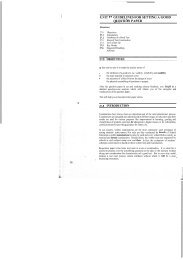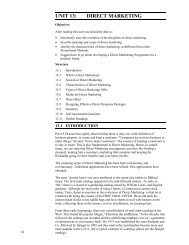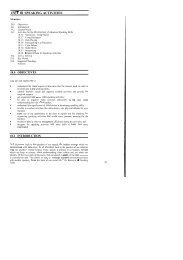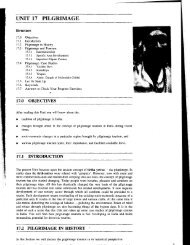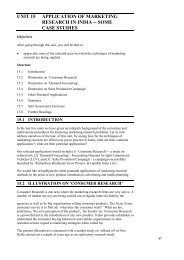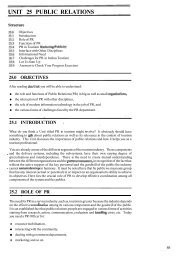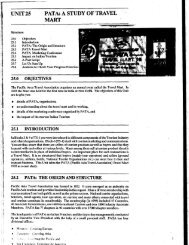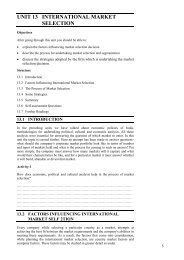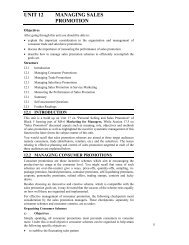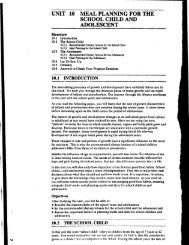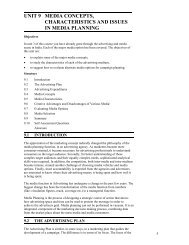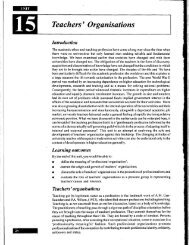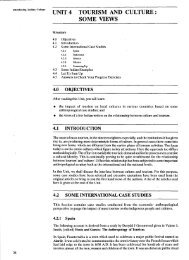UNIT 1 RADIO: A MEDIUM OF MASS COMMUNICATION - eGyanKosh
UNIT 1 RADIO: A MEDIUM OF MASS COMMUNICATION - eGyanKosh
UNIT 1 RADIO: A MEDIUM OF MASS COMMUNICATION - eGyanKosh
You also want an ePaper? Increase the reach of your titles
YUMPU automatically turns print PDFs into web optimized ePapers that Google loves.
Radio Broadcasting:<br />
An Introduction 1.2 CONCEPT <strong>OF</strong> <strong>COMMUNICATION</strong><br />
- In order to appreciate the role of radio as a medium of mass communication, we need to<br />
understand what is the concept of communication, what are the various functions and types<br />
of communication.<br />
1.2.1 Meaning and Definition<br />
Talking with someone, arguing in a discussion, speaking in public, reading a newspaper,<br />
watching a television programme, etc., are all different kinds of communication that we are<br />
engaged in everyday. It means that we are constantly exchanging our thoughts, ideas, and<br />
notions with someone or the other either to satisfy our physical, emotional or other needs or<br />
to get work done. It is obvious that communication is an integral part of one's life. In fact,<br />
it would be impossible to think of a society in the absence of communication.<br />
The word 'Communication' is derived from the Latin word "cornmunis", which means, to make<br />
common or to share. There are numerous definitions of communication, and there is yet no<br />
agreement on any single definition. Some of the more functional definitions of communication<br />
describe it as "the transfer or conveying of meaning" (Oxford ~ictionary), "tra"nsrnission of<br />
stimuli" (Colin Cherry), "one mind affecting another" (Claude Shannon); "one system<br />
influences another" (Charles E. Osgood), "the mechanism through which human relations<br />
exist and develop," or "sharing of txperience on the basis of commonness" (Wilbur Schramm).<br />
1<br />
You communicate to share a message or information. Communication is more than mere<br />
transferring or transmission of ideas or thoughts. It is not a static act, as some of the earlier<br />
definitions suggest, but it is a dynamic process of action and interaction towards a desired goal.<br />
Thus, communication is, a process of sharing or exchange of ideas, information, knowledge,<br />
attitude or feeling among two or more persons through certain signs and symbols.<br />
What do we find in this definition? It says that two or more persons are involved in the act, the<br />
one who gives information (sender) and the one who receives it (receiver). What is being shared?<br />
- an idea or an information or an attitude (message). And through what means? The information<br />
is shared or exchanged through certain signs and symbols; it could be language, oral or written.<br />
While sharing and exchanging ideas or information with others, we are actually interacting with<br />
people and establishing a kind of relationship that helps us to achieve the task set before us.<br />
1.2.2 Funktions of Communication<br />
Communication is vital for human existence, and for the progress of humanity. No person,<br />
group or society can exist without interaction with others. Think for a moment what would<br />
happen to us if we did not talk with anyone at home; didn't listen to leytures at.schoo1 or<br />
college; didn't speak to friends and co-workers; or didn't play games or watch TV or films?<br />
And what would life be like in the absence of news, views, facts, figures or information?<br />
Obviously, we would be miserable and would miss out on many opportunitieSand challenges<br />
offering us security and success in our personal and professional life. Being at the heart of all<br />
social action and interaction, communication functions as a relating tool that creates<br />
understanding, facilitates work, and strengthens collective living among people.<br />
Essentially, the primary function of communication is to infonn, instructleducate, entertain,<br />
influence and persuade people to make them function smoothly and effectively. Besides,<br />
communication has a secondary function to perform as well: through debate and discussion<br />
it promotes cultural integration, it fosters consensus, creativity, and understanding among<br />
people, groups and societies enabling them to live in peace and harmony.<br />
1.2.3 Types of Communication<br />
Human beings are engaged in a variety of communication acts. Although each type of 7<br />
communication appears-to have distinctive features, they are all much alike in the sense that<br />
ore enters into a meaningful relationship with one or more persons by means of signs and<br />
symbc!s. These Ire:<br />
Intrapersonal Ccmmunication;<br />
Interpersonal Communication;<br />
Group Communication; and<br />
Mass Communication. .<br />
I<br />
i<br />
1





